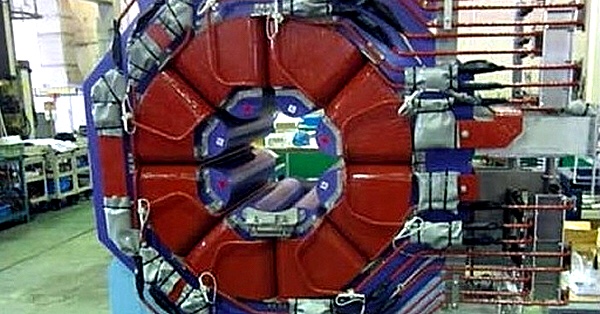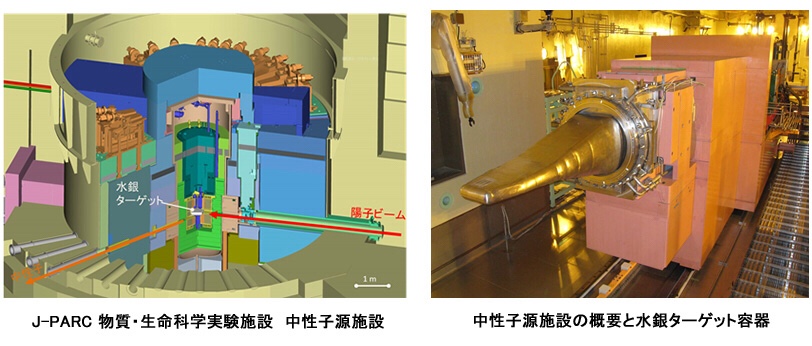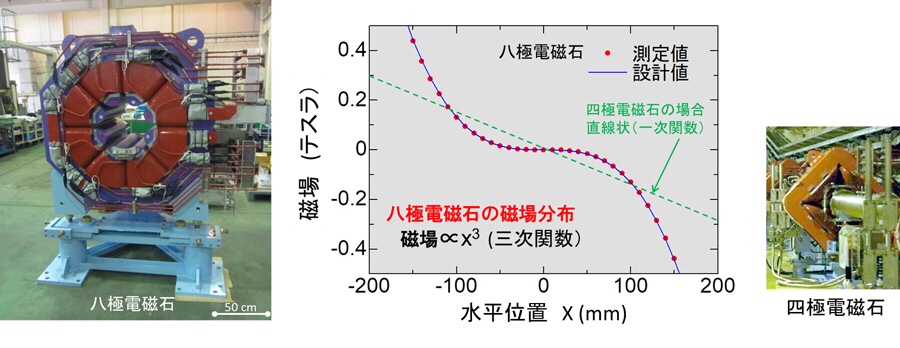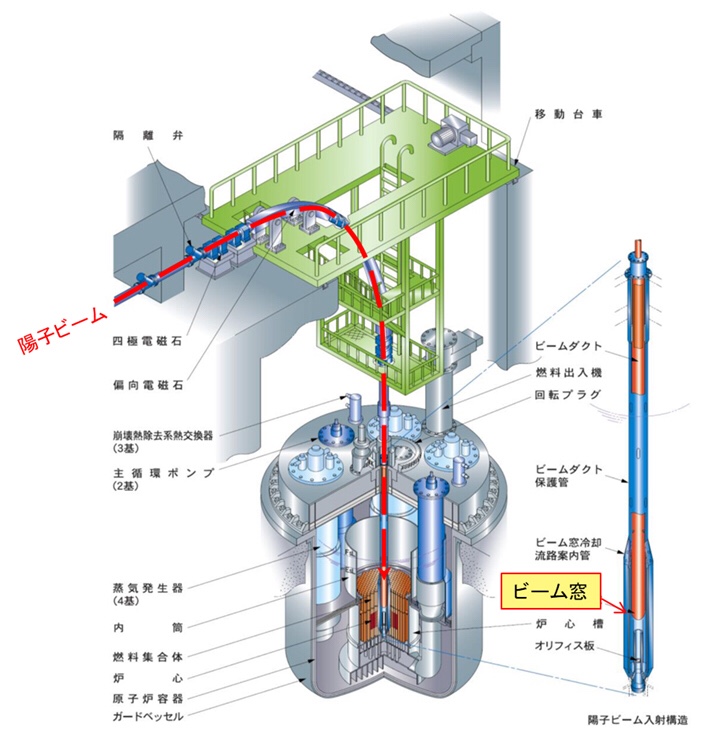

Fig. 1 Eight-pole electromagnet used for beam shaping (left) and its magnetic field distribution (center). The quadrupole electromagnet (right), which has a converging/diverging function like an optical lens for transporting a beam with an accelerator, has a linear (first-order function) magnetic field distribution, and the beam width can be changed, but the shape is I can’t change it. On the other hand, an octupole electromagnet having eight poles has a magnetic field distribution of a cubic function, and the magnetic field becomes stronger as the distance from the center of the electromagnet increases. Due to this characteristic (non-linearity), it is possible to convolve around only the foot of the beam and shape the beam shape flat.

Figure 2 Conceptual diagram of the method of reducing the current density by beam shaping. With linear optics, the beam shape cannot be changed, but with nonlinear optics, the beam shape can be made flat, and the current density at the center can be reduced without hitting the beam on the structural material outside the target. I can do it.

Figure 6 Outline of accelerator drive system
J-PARC: Proton beam shaping technology developed: Safe operation of high-intensity accelerator
-Beam shaping method that makes full use of non-linear optics reduces target damage and contributes to facility safe operation-
J-PARC:
[Summary of presentation]
In the neutron source facility, the target steel container is exposed to a high-intensity proton beam.
Even at J-PARC’s neutron source facility, steel vessels are always damaged by the beam.
Conventional beam conditioning technology:
In neutron source facilities, it is necessary to reduce the current density of the beam to reduce damage.
The beam shape cannot be changed with conventional beam adjustment technology.
Therefore, it was difficult to reduce the current density.
Beam shaping with an octupole electromagnet:
It has long been known that an octupole electromagnet can be used to shape the beam into a flat shape and reduce the current density.
However, this shaping method was thought to be complicated to adjust parameters such as the magnetic field, so it was difficult to put it to practical use with a high-intensity beam.
This beam shaping technology:
In this research, we analyze this beam shaping method in detail.
As a result, it was clarified that the beam shape is characterized by only two parameters.
Beam shaping is now easier.
Shape the beam as expected:
When I actually tried this beam shaping method,
You can shape the beam as expected,
The current density of the beam could be reduced by 30%.
Important technology of high intensity accelerator facility
With the development of this beam shaping technology, the J-PARC neutron source facility has become able to operate a more stable and intense beam.
This result is an important technology for suppressing target damage in future high-intensity accelerator facilities.
Japan Atomic Energy Agency: Press Release
https://www.jaea.go.jp/02/press2020/p20072202/
Phys. Rev. Accel. Beams 23, 062802 (2020) –
Two-parameter model for optimizing target beam distribution with an octupole magnet
Shin-ichiro Meigo, Motoki Ooi, and Hiroshi Fujimori
Phys. Rev. Accel. Beams 23, 062802 – Published 23 June 2020
ABSTRACT
As hadron accelerators achieve increasing beam power, damage to targets is becoming increasingly severe.
To mitigate this damage,
nonlinear beam optics based on octupole magnets is attractive.
Nonlinear optics
can decrease the beam-focusing hazard due to failure of the rastering magnet.
As a side effect of nonlinear optics,
the beam size at the tail is known to expand drastically compared with linear optics, owing to defocusing in the nonlinear case;
this may cause severe beam loss downstream of the octupole magnets.
Beam shape and beam loss as a side effect of nonlinear optics have thus far been studied via a simplified filament model
that ignores beam-divergence spread at the octupole magnet, so that the problem may be treated by a simplified transfer matrix.
Several beam-tracking studies
have been performed for the specified case given by the specified emittance and Twiss parameters, whereas a simplified model is required for application to the pragmatic beam tuning.
In this study, a new generalized model
is proposed for application to an octupole magnet, regardless of the filament-model approximation.
It is found that the transverse distribution obtained by beam tracking can be specified by the introduction of only two parameters, namely the normalized octupole strength of
K∗8 and the cotϕ
of the phase advance from the octupole to the arbitrary position.
With the new generalized model, the distribution with allowable beam loss is studied in detail.
https://journals.aps.org/prab/abstract/10.1103/PhysRevAccelBeams.23.062802